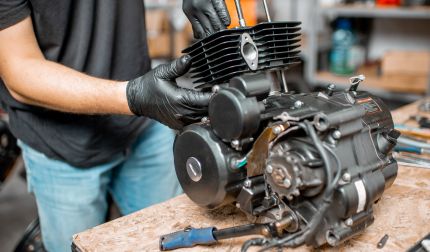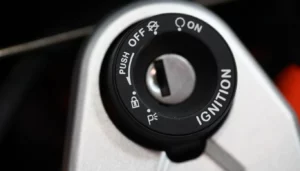Motorcycles’ electrical systems require regulator rectifiers. It regulates the motorcycle’s alternator voltage and rectifies it from AC to DC to power the battery, headlight, ignition and other electrical components. The regulator rectifier protects the bike’s electrical components from overvoltage and power fluctuations.
Electrical issues cause many motorcycle problems. The motorcycle may have trouble starting, dim headlights, inconsistent ignition, a weak battery, or complete electrical failure. The regulator rectifier can overcharge or undercharge the battery, causing many of these electrical issues.
What Is the Regulator Rectifier
Motorcycles have regulator rectifiers. First, it rectifies the alternator’s AC into DC for the motorcycle’s electrical components. Second, it regulates voltage, preventing voltage spikes from damaging the battery and other components.
A regulator rectifier has diodes, resistors, and capacitors. Diodes allow one-way current flow to convert AC to DC during rectification. However, the resistors and capacitors regulate voltage by absorbing and releasing power as needed.
The regulator rectifier controls battery charging and voltage. It converts AC to DC to power the battery. Regulating voltage output ensures that the battery and other electrical components receive consistent and safe power. A motorcycle’s electrical system can suffer from weak batteries to complete failure without a regulator rectifier.
Symptoms of a Bad Regulator Rectifier on A Motorcycle?
Recognizing regulator rectifier symptoms helps diagnose and fix the problem before it causes more damage. Dead batteries, overheating, dim lights, weak ignition, and fluctuating power are common symptoms. A failing regulator rectifier can cause a complete breakdown, stranding a rider.
1. Dimming or Flickering Headlights
Dimming or flickering headlights are often an early warning sign of a failing regulator rectifier. Because the regulator rectifier is responsible for ensuring a steady flow of power to the bike’s electrical system, any issues with it can result in inconsistent power to the headlights, leading to noticeable dimming or flickering.
2. Inconsistent Battery Charging
Another common symptom of a bad regulator rectifier is inconsistent battery charging. The regulator rectifier may be malfunctioning if your battery dies quickly or has trouble staying charged.This could be due to the device failing to convert AC to DC properly or not regulating the voltage effectively.
3. Electrical System Failures
Broad electrical system failures could also indicate a problem with the regulator rectifier. For instance, if your motorcycle’s ignition system is erratic or if the electric start fails to work, the root cause could be an issue with the regulator rectifier. Remember, this device provides power to all of the bike’s electrical components – so if it’s failing, multiple systems could be affected.
4. Overheating of the Motorcycle
Overheating is another symptom of a failing regulator rectifier. If the rectifier fails, the battery overcharges, generating heat. This shortens the battery’s lifespan and can overheat other motorcycle parts, causing more serious mechanical issues.
5. Battery Drainage or Discharge Problems
If your motorcycle’s battery constantly drains or discharges, even when the bike is off, it could be a sign of a failing regulator rectifier. The regulator rectifier should prevent the battery from discharging when the motorcycle isn’t running, so continual battery drainage might indicate that it’s not functioning properly.
6. Issues with Accessories or Auxiliary Equipment
Finally, any problems with accessories or auxiliary equipment could also indicate a bad regulator rectifier. Accessories like radios, GPS devices, and additional lights all rely on the bike’s electrical system to function. If these systems are behaving erratically, it might suggest that the regulator rectifier is failing to provide consistent power to the bike’s electrical components.
Diagnosing a Bad Regulator Rectifier
Motorcycle regulator rectifiers must be diagnosed step-by-step to assess electrical system performance. How to:
Basic Tools and Equipment Required
To diagnose a bad regulator rectifier, you’ll need a few basic tools and equipment. These include a multimeter, a basic tool set (for accessing the battery, connections, and potentially the stator), a battery charger (for recharging the battery if necessary), and personal protective equipment like gloves and safety glasses to ensure safety during the diagnostic process.
Step-by-Step Diagnostic Process
- Testing the Charging Voltage
The first step is to test the charging voltage of your motorcycle. Connect the multimeter to your motorcycle battery while the bike is running. The voltage reading should typically be around 14-15 volts for a 12-volt battery system. Your regulator rectifier may be malfunctioning if the voltage fluctuates.
- Inspecting the Battery and Connections
Next, inspect the battery and its connections. Charge and maintain the battery. If it’s old or damaged, it may not hold a charge properly, which can mimic the symptoms of a bad regulator rectifier. Similarly, check that all connections are clean and secure. Poor connections can also cause charging issues.
- Examining the Stator
The stator, a part of the motorcycle’s alternator, generates the AC current that the regulator rectifier then converts to DC. Therefore, it’s important to check the stator for any issues. Using the multimeter, test the resistance between the stator’s output wires and ground. Stator problems may occur if resistance is outside the manufacturer’s range.
- Checking for Short Circuits or Grounding Issues
Finally, check for any short circuits or grounding issues in the electrical system. Use the multimeter to check continuity between the regulator rectifier’s output wires and ground. If there’s continuity, it means there’s a short circuit, which could be causing your problems. Additionally, examine the regulator rectifier and its wiring for any signs of damage, such as burned or melted wires, which could indicate a grounding issue.
Causes of Regulator Rectifier Failure
There are several common causes of regulator rectifier failure in a motorcycle:
1. Overcharging or Excessive Voltage
Overcharging is a common cause of regulator rectifier failure. The regulator rectifier can overheat and fail if the battery is constantly charged above its capacity. Similarly, excessive voltage, either from the alternator or the battery, can also cause damage to the regulator rectifier.
2. Heat and Thermal Stress
Heat and thermal stress are another major cause of regulator rectifier failure. The process of rectification and voltage regulation can generate a significant amount of heat. It can fail early if it doesn’t have enough cooling or is exposed to high operating temperatures. Thermal stress can also be caused by other overheating components in close proximity to the regulator rectifier.
3. Voltage Spikes or Electrical Surges
Voltage spikes or electrical surges can also lead to regulator rectifier failure. Lightning, alternator power surges, or faulty wiring can cause these. The regulator rectifier is designed to handle a certain range of voltages, and any sudden spike outside this range can cause it to fail.
4. Poor Quality or Defective Components
Like any piece of equipment, the regulator rectifier can fail due to poor quality or defective components. A manufacturing defect, poor materials, or wear and tear may cause this. Regular maintenance and high-quality parts can prevent this failure.
5. Wiring and Connection Problems
Lastly, wiring and connection problems can cause the regulator rectifier to fail. The regulator rectifier may malfunction if the wires connecting it to the electrical system are damaged or corroded. Loose or poor connections can also cause problems, as they can lead to inconsistent voltage regulation or even short circuits. Regular inspections and proper maintenance can help identify and correct these issues before they lead to regulator rectifier failure.
Preventive Measures to Avoid Regulator Rectifier Issues
There are several preventive measures that you can take to avoid regulator rectifier issues:
1. Regular Maintenance and Inspection
Regular maintenance and inspection of the motorcycle’s electrical system can go a long way in preventing regulator rectifier issues. This includes checking the regulator rectifier for signs of damage, ensuring all connections are secure, and checking the voltage output on a regular basis. Doing so can help you catch any issues early before they lead to a complete failure.
2. Installing Heat Dissipation Solutions
Given the role of heat in many regulator rectifier failures, installing heat dissipation solutions can be a smart preventive measure. This might include a heat sink or fan for the regulator rectifier, which can help keep it cool even under heavy load. Additionally, making sure that the regulator rectifier is installed in a location with good airflow can help prevent overheating.
3. Upgrading to High-Quality Regulator Rectifiers
If your motorcycle’s regulator rectifier is of poor quality or old, upgrading to a high-quality unit can prevent future issues. Higher-quality regulator rectifiers typically have better heat dissipation, are more efficient at rectification and voltage regulation, and are more resilient to voltage spikes and other issues.
4. Proper Battery Care and Maintenance
Finally, proper battery care and maintenance can help prevent regulator rectifier issues. This includes regular charging and discharging to maintain battery health, as well as regular inspections for signs of damage or corrosion. A healthy, well-maintained battery can help prevent excessive strain on the regulator rectifier, reducing the risk of failure.
Frequently Asked Questions (FAQs)
A. What is the purpose of a regulator rectifier in a motorcycle?
A motorcycle’s regulator rectifier converts the stator’s alternating current (AC) into direct current (DC) for the electrical components and regulates the voltage to prevent overvoltage damage.
B. How can I determine if my regulator rectifier is bad?
Common symptoms of a bad regulator rectifier include inconsistent battery charging, dimming or flickering headlights, frequent battery drains, and electrical system failures. For a detailed diagnosis, it’s best to use a multimeter to check the charging voltage and inspect the battery, connections, and stator.
C. Can a bad regulator rectifier drain the motorcycle’s battery?
Yes, a bad regulator rectifier can drain the battery, even when the motorcycle is off. . Overcharging can also cause battery failure.
D. What are the possible causes of a failing regulator rectifier?
Possible causes include overcharging or excessive voltage, heat and thermal stress, voltage spikes or electrical surges, poor quality or defective components, and wiring and connection problems.
E. How often should I inspect and maintain my regulator rectifier?
It’s a good practice to inspect and maintain your regulator rectifier as part of your regular motorcycle maintenance, which typically occurs every few months or few thousand miles.
Conclusion
Maintaining your motorcycle’s electrical system requires detecting and fixing regulator rectifier issues. Check your regulator rectifier regularly for damage or malfunction and fix any issues immediately.
Maintaining your regulator rectifier and fixing issues quickly can make riding safer and more reliable. It can prevent unexpected breakdowns, prolong your motorcycle’s battery and electrical components, and give you peace of mind while riding.
Regular inspections, proper cooling, upgrading to a high-quality unit when needed, and good battery maintenance can keep your regulator rectifier working well. These expert tips can reduce regulator rectifier failure and maintain your motorcycle’s electrical system.






